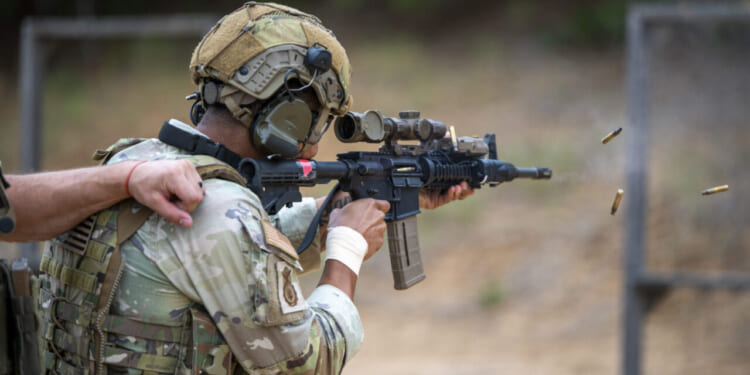Army Special Forces operators specialize in unconventional warfare and foreign internal defense.
Over the summer, Army Green Berets worked with European special operations units in preparation for a conflict with Russia.
During two separate trainings, one in the United States and another in Europe, Army Special Forces operators worked with Polish and British special operations forces.
Air Mobility and Direct Action Training
The exercise in Poland focused on air mobility techniques, including insertions and extractions with CH-47 Chinook helicopters. The goal of the joint special operations training was to enhance interoperability, integration, and warfighting capabilities among US special operators, conventional Army aviation units, and NATO special operations forces.
During one particular training event, an Army CH-47 Chinook came in and hoisted a special operations tactical vehicle before taking off. In another training event, a CH-47 chopper skimmed the waters of a lake, allowing US and Polish commandos to jump in safely and begin a simulated insertion of a target. Thereafter, the CH-47 Chinook conducted another low pass, allowing the commandos to safely exfiltrate from their target.
Air mobility is key to effective special operations. Although the US military has a dedicated rotary aviation unit for that purpose, the Army’s 160th Special Operations Aviation Regiment, “The Night Stalkers,” operational demands often require conventional Army, Air Force, Marine Corps, and even Navy helicopter units to carry special operators. Training events such as this one offer an excellent opportunity for conventional crews to familiarize themselves with the rigors of special operations missions.
In a separate training event just a few weeks earlier, Polish and British special operators visited the 10th Special Forces Group’s headquarters in Colorado and worked together for three weeks. Their training culminated in a final large-scale direct-action exercise in which several different teams converged on a compound, capturing or killing a high-value target, and conducting sensitive site exploitation for actionable intelligence.
Although that particular culminating exercise resembled operations that US special operations units conducted in Iraq, Syria, and Afghanistan, it has applicability in a near-peer warfare situation, too.
Polish special operations units have worked and fought alongside their US counterparts several times in the past. Polish Grom frogmen, for example, took part in the invasion of Iraq in 2003, taking down an Iraqi oil rig in the Persian Gulf. Polish commandos also deployed to Afghanistan, fighting the Taliban and al-Qaida fighters.
The 10th Special Forces Group
The 10th Special Forces Group that led the exercises focuses on the European Continent. It was established in 1952, and it is the first Green Beret unit.
Army Special Forces operators specialize in unconventional warfare and foreign internal defense.
Visionary Army officers saw that in a potential war with the Soviet Union, the Russian armies would likely overrun large swaths of Western Europe before they were stopped. Such a scenario would create an opportunity for a small team of commandos to stay or infiltrate behind the Soviet lines and wage a guerrilla campaign, attacking supply lines and other high-value military targets. Green Berets were even given a unique nuclear role.
The US military designed a portable nuclear bomb, the MK54 Special Atomic Demolition Munition (SADM), that could fit in a special rucksack and assigned some hand-selected Green Beret teams as “Green Light” detachments that would deploy behind Soviet lines and detonate their nuclear rucksacks.
More than 30 years after the end of the Cold War, the 10th Special Forces Group is once more preparing for a conflict with Russia.
About the Author: Stavros Atlamazoglou
Stavros Atlamazoglou is a seasoned defense journalist specializing in special operations and a Hellenic Army veteran (national service with the 575th Marine Battalion and Army HQ). He holds a BA from the Johns Hopkins University and an MA from the Johns Hopkins’ School of Advanced International Studies (SAIS). His work has been featured in Business Insider, Sandboxx, and SOFREP.
Image: DVIDS.


















